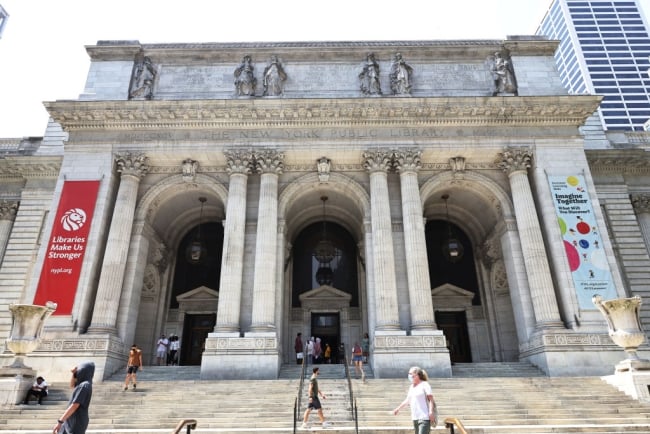You have /5 articles left.
Sign up for a free account or log in.

New York City’s public school system is leveraging partners to boost FAFSA completion, including the public library, which has hosted drop-in sessions with financial aid experts.
Michael M. Santiago/Getty Images
Well before New York governor Kathy Hochul declared April “Financial Aid Awareness Month,” Kristen Harris was taking an all-hands-on-deck approach to improving her city’s financial aid form submission rate.
Harris, the executive director of college and career planning for New York City Public Schools, said that when delays and form issues began swirling after the bungled rollout of the new Free Application for Federal Student Aid this spring, she knew the city’s high schools would need more than their staff counselors to ensure students didn’t get left behind in the confusion.
So far, the numbers don’t look good. Completions are down 24 percent in New York state as of March 29, according to data from the National College Attainment Network. In the city itself, they’re down from 35,500 last year to 19,500 this year, a decline of more than 45 percent, according to estimates provided by NCAN—steeper than in any U.S. state.
So Harris marshaled the city’s significant resources, leveraging partnerships with the public colleges and advocacy groups that have stewarded postsecondary pathways for decades.
“We have a culture of collaboration in this city, and we’re leaning in to that ecosystem,” she said. “That’s how we’re going to fill the gap.”
Harris’s FAFSA fire-fighting machine includes the New York Public Library system, which has been hosting late-night FAFSA completion sessions for the past month, and The City University of New York, which is sending already-strapped financial aid officers to advise high schools.
“This process—helping students get to college, figuring out how to pay for it—is always stressful, but the FAFSA mess has really exacerbated that,” Harris said. “The response both from students and staff is that it’s frustrating, and it’s hard, and having an extra layer of support has been a huge help.”
Working ‘FAST’
CUNY is also leveraging its most abundant resource in service of the completion effort: current college students. The university system’s peer counseling program already places dozens of its students in part- and full-time assistant counselor roles in high schools around the city, helping over 55,000 high school students.
This week the university also launched a Financial Aid Support Team, or FAST, to focus specifically on mounting FAFSA difficulties. Members will manage FAFSA drop-in centers in libraries, shelters and other public spaces around the city for the next month—or however long it takes to get students the aid they need.
Crystal Luna Serrano, a senior at CUNY’s John Jay College of Criminal Justice in Manhattan, has been working 15 hours a week as a high school counseling assistant all year. She began her second job as a FAST coach on Wednesday, and said she’s eager to help students from other high schools in the city. If what she’s seen at her small charter school is any indication, her help is desperately needed.
“It’s taken up the majority of my time this spring, and it’s really upsetting for students,” she said. “They’re coming into my office every week with new problems … I wonder, what would happen if I wasn’t here?”
It’s not just FAFSA submissions that are bogging students down. Many applicants who did submit have received messages flagging issues with their forms, or asking them to make some specific change they don’t understand. That tracks with the latest education department data released Wednesday morning showing that up to 16 percent of the 7 million forms submitted so far will need corrections—which students won’t be able to make until early next week.
Laura Myers, CUNY’s assistant dean of K16 initiatives, oversees the FAFSA completion effort. She said setting students in the K-12 system on the path to postsecondary opportunities has always been a central part of her job—and the public university system’s mission—and this year the new FAFSA is the biggest potential barrier to college for the city’s low-income students.
“We’ve been doing this work to support college and career readiness for many years now, but this year we’re really having to double down on the FAFSA,” she said. “Normally in the spring we’re starting to work with juniors, but instead you’re stuck making sure that the seniors are getting the support that they need because they’re really stalled in the financial aid process. So we wanted to beef up that support.”
Myers’ job technically falls under the university’s enrollment management office, reflecting the fact that for CUNY—as for many institutions serving primarily low-income students—the FAFSA completion crisis is also an enrollment issue.
“We’re going to be working with students whether or not they're going to CUNY. All of our programs are supporting students whatever their path may be,” she said. “But of course, many of them do choose CUNY … so we’ll have to see how enrollment fluctuates this year.”
A Chopped Cheese and Some Student Aid
Harris and her team have been working to get the word out on the FAFSA resources available to low-income families, posting flyers for FAFSA drop-in centers and help sessions at subway stations and bodegas throughout the city, handing them out in homeless shelters and around rent-controlled housing developments.
They’ve also been meeting students where they are to keep them up-to-date on shifting deadlines and available resources. Harris said they’re sending text reminders twice a week to high school seniors enrolled in the city’s mentorship program, Next STEPS (Striving Toward Engagement and Peaceful Solutions), encouraging those most vulnerable to frustration and apathy to complete the form.
“The biggest challenge is making sure the right people have the right information at the right time,” Harris said. “Doing that in a district with 500-plus high schools takes quite an effort … but I think those efforts have been fruitful.”
The population most in need of FAFSA support is students from mixed-status families, who have been essentially locked out of completion since the form launched late last year. Serrano can relate because she also comes from a mixed-status family. Without federal and state aid, she said, she likely never would have arrived at the first stop in her higher ed journey, LaGuardia Community College in Queens.
“I have a student who was so excited, who started her FAFSA on December 31, the day it launched,” she said. “She still hasn’t completed it. Every week I try to help her, to get through to the support hotline and figure it out, but it’s hard.”
Serrano eventually wants to become a full-time high school counselor. This spring has proved to be a uniquely difficult trial in her professional development, but she said that if she could help students through the FAFSA fiasco, she could tackle any crisis.
The city’s efforts won’t be reflected in the numbers for at least a few more weeks. But for Harris, successfully boosting completion would be a testament to its “community of support” and the power of collaboration.
“We have to make sure we’re wrapping our arms around these students because it’s not their fault, and they shouldn’t bear the brunt of what is happening,” she said. “Everyone feels a responsibility to remove as much burden from students and families as they can.”









